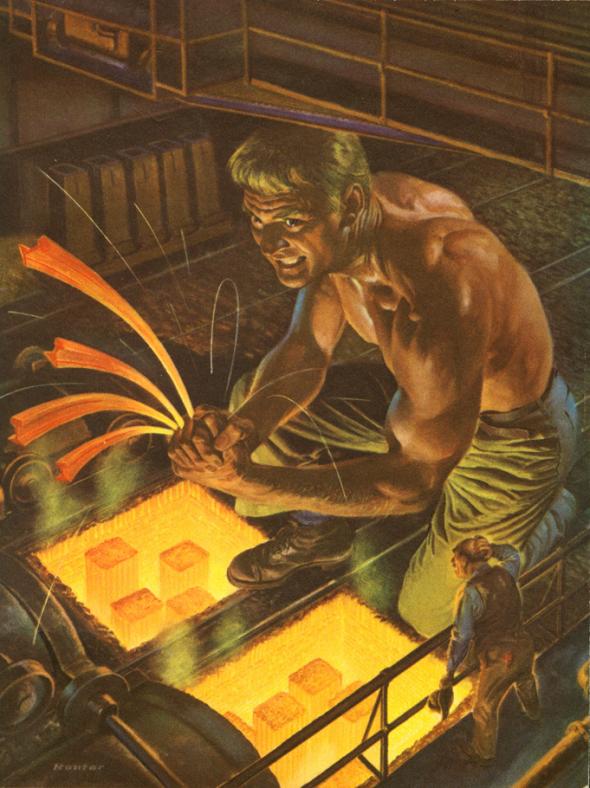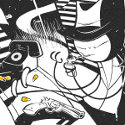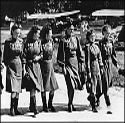|
WebDog posted:Want this so bad for my Death Korps of Kreig army.
|
|
|
|

|
| # ? Apr 29, 2024 17:39 |
|
DarkCrawler posted:There were some tacky WWII posters too... I'm amused by the unintentional (or maybe not?) homoerotic vibe of this propaganda poster.
|
|
|
|
Can anyone recommend any good books on the Raid at Dieppe?
|
|
|
|
Today I read this about the USS Gloucester:quote:The second Gloucester (PF-22), originally classified PG-130, was launched on 12 July 1943 at the Walter Butler Shipbuilding Company in Superior, Wisconsin, under a Maritime Commission contract, sponsored by Mrs. Emily K. Ross; acquired and simultaneously commissioned on 10 December 1943. How in the heck did they get a frigate from Lake Superior to the ocean?
|
|
|
|
Was going to say "The St Lawrence Locks" but that wasn't until 1959 soooo....
|
|
|
|
Down the river from Chicago to the Gulf of Mexico?
|
|
|
|
Nenonen posted:There were a multitude of solutions, but they normally involved a good deal of calculations, drawings on a millimeter grid, correction charts for wind, temperature, air pressure etc. But still much depended on manual calculations. There were also rules of thumb: eg. "a 10º change of temperature from +15ºC changes range by 5%". I love such applications of analog computing. Rangefinders on early combat ships, stuff like that. Particularly like the principles behind the Sidewinder missile. Designing a heat-seeking missile isn't hard, you could probably make one with Legos these days... but not so much in the era where computers were measured in the roomfuls. So the engineers of the day just used a couple of spinning mirrors. quote:Early development
|
|
|
|
How different were WW1 U-Boats compared to WW2 U-Boats? I keep hearing about how April 1917 was a really really bad month to be in the British Merchant Marine, though I can't quite imagine how advanced submarine technology would be by then.
|
|
|
|
gradenko_2000 posted:How different were WW1 U-Boats compared to WW2 U-Boats? I keep hearing about how April 1917 was a really really bad month to be in the British Merchant Marine, though I can't quite imagine how advanced submarine technology would be by then. It didn't have to be super advanced when anti-submarine warfare was even more primitive. Eg. research for first sonar only started toward the end of the war and was not finished before the war had ended. Reliable depth charges had to be developed as the war went on. Airplanes of the time also weren't quite as good in submarine hunting due to limited range and weapons. Most importantly, for a long time the Brits believed that arranging convoys would be futile, as a lone ship has better chances of making it through than if they all travelled together. After the convoys were introduced, losses to submarines dropped from 25% to 1% of shipping. Of course this lesson was forgotten by WW2... WW1 submarines weren't quite as advanced as what the branch became by WW2, and perhaps could be better described as torpedo boats that could dive for a while. WW2 subs at least were faster and had better range while submerged. But ASW had gotten up to them by then. You couldn't have a battle account like this in WW2: quote:On 22 September 1914, while patrolling the Broad Fourteens, a region of the southern North Sea, U-9 found a squadron of three obsolescent British Cressy-class armoured cruisers (HMS Aboukir, HMS Hogue, and HMS Cressy), (sardonically nicknamed the "Live Bait Squadron") which had been assigned to prevent German surface vessels from entering the eastern end of the English Channel. She fired all six of her torpedoes, reloading while submerged, and sank all three in less than an hour. 1459 British sailors died. It was one of the most notable submarine actions of all time. Members of the Admiralty who had considered submarines mere toys no longer expressed that opinion after this event.
|
|
|
|
gradenko_2000 posted:How different were WW1 U-Boats compared to WW2 U-Boats? I keep hearing about how April 1917 was a really really bad month to be in the British Merchant Marine, though I can't quite imagine how advanced submarine technology would be by then. U-boats in WWI tended to use their deck guns over torpedoes, due to lack of planes trying to hunt them down. I believe the biggest U-boat ace of WWI almost exclusively used his deck gun.
|
|
|
|
Mr. Sunshine posted:Dude, I'm in the Swedish National Guard, and we're this close to issuing orders over facebook! I laughed way too hard at this... I'm slowly but surely reading every single page of this thread, but in the meantime, I had another, somewhat topical hypothetical for the experts -- how would a war between India and Pakistan shake out now? At least to me, comparing the numbers on paper, it seems like Pakistan wouldn't really stand a chance against a numerically and technologically superior Indian force. But that's assuming a pitched conventional war, and we all know Pakistan likes to play dirty. Vague question, but I'm open to any and all speculation. Thoughts? In the meantime, still wishing I could find a good book on the Iran-Iraq War or the 1998-200 Ethiopian-Eritrean War (that's more about day-to-day combat operations as opposed to grand geopolitical and sociocultural reasons for the wars). Farecoal posted:U-boats in WWI tended to use their deck guns over torpedoes, due to lack of planes trying to hunt them down. I believe the biggest U-boat ace of WWI almost exclusively used his deck gun. This brings up another question: any of you bubbleheads know why subs don't use any anti-aircraft weaponry anymore? Seems like it'd be easy enough to fire of a SAM at a pursuing ASW aircraft.
|
|
|
|
A Fistful of Dicks posted:This brings up another question: any of you bubbleheads know why subs don't use any anti-aircraft weaponry anymore? Seems like it'd be easy enough to fire of a SAM at a pursuing ASW aircraft. Presumably because that would very definitely give away its presence, leading to it "trading" with the aircraft. And subs are way more expensive than most non-B2 aircraft.
|
|
|
|
Propaganda image. hellzyeahf96 by RReiheld, on Flickr I always terribly impressed with Kulturterror though, as propaganda imagery goes.  For those who havn't seen it to death, it is Nazi propaganda (versions appeared both in Norway and the lowlands), and the man with the big ears (because he listens to too much allied propaganda) says "America will save European culture from destruction....with what right?"
|
|
|
|
A Fistful of Dicks posted:I laughed way too hard at this... http://en.wikipedia.org/wiki/Indo-Pakistani_War_of_1999 Nothing beyond that due to nuclear weapons. Pakistan wouldn't stand a chance and never has against a conventional war with India, but it doesn't have to.
|
|
|
|
Slo-Tek posted:"America will save European culture from destruction....with what right?" World's Most Beautiful Leg gives you the authority to do so, obviously.
|
|
|
|
Slo-Tek posted:I always terribly impressed with Kulturterror though, as propaganda imagery goes. That one was drawn by Harald Damsleth on commission from Nasjonal Samling, Quisling's party. He made several memorable ones. "The smile of Victory"  "Now what matters is to not lose your head". The weight on the right reads "Total Bolshevik victory on the Eastern front." "The wishful dream may become a nightmare"  "And here do you sleep."  "No!" "A blessed meeting"  "Dear brother, with these beautiful crosses we wish to strengthen your faith." Placard held by big-eared man: "Christianity is being introduced in the Soviet Union." "Front against Bolshevism"  "Where do YOU stand today?" "All for Norway" (Motto of the king)  "The help from England" The "H" is actually the monogram of king Haakon 7.
|
|
|
|
Oh god the Norwegian winter campaign. So depressing.
|
|
|
|
|
"Dad, why did you take me to a gay steel mill?"
|
|
|
|
Thanks for the responses about WW1 U-boats, Nenonen and Farecoal. The subject piqued my interest enough that I went out and bought 1914 Shells of Fury as a WW1 subsim. Much as I expected, the lack of computers at the time means leading a target with a torpedo shot will have to be done manually, as would be ranging shots with the deck gun.
|
|
|
|
Copernic posted:Today I read this about the USS Gloucester: Though the St. Lawrence Locks weren't ready until 1959, there was already a pretty extensive system of canals and waterways up around the Great Lakes by the late 19th century. I presume they used those? I've been trying to figure out who the hell that fourth guy on Trench_Rat's poster is and I'm not doing very well at all. The best guess I have is http://en.wikipedia.org/wiki/Otto_Liman_von_Sanders but why they would worry about a random advisor instead of an admiral or something is beyond me.
|
|
|
|
Mister Adequate posted:Though the St. Lawrence Locks weren't ready until 1959, there was already a pretty extensive system of canals and waterways up around the Great Lakes by the late 19th century. I presume they used those? He isn't a random advisor, he played a key part in bringing Turkey into the war, as well as commanding the defense at Gallipoli.
|
|
|
|
mllaneza posted:He isn't a random advisor, he played a key part in bringing Turkey into the war, as well as commanding the defense at Gallipoli. You're right, I was being overly dismissive of the role he played. I can easily see why he would be highlighted as an example of German aggression by the Entente.
|
|
|
|
Fourth man is Crown Prince Wilhelm http://www.iwm.org.uk/collections/item/object/30992
|
|
|
|
BBC has a tragicomical story about John Capes, a man who escaped from a submarine sunken to the depth of 171 feet (52 meters) in WW2 and then spent 1½ years dodging Italian patrols in Greece. And he wasn't even part of the crew... http://www.bbc.co.uk/news/magazine-15959067
|
|
|
|
gradenko_2000 posted:How different were WW1 U-Boats compared to WW2 U-Boats? I keep hearing about how April 1917 was a really really bad month to be in the British Merchant Marine, though I can't quite imagine how advanced submarine technology would be by then. Early in WW2 the peak of submarine technology was the german type VIIC, and the intensive development throughout the war led to the age-defining type XXI. Early on, the subs were somewhat improved on terms of range and depth, but Wolfpack tactics apart were pretty much similar to the WW1 conterpart. Deck guns were still used, indeed the Royal Navy fielded some notable designs that had dual turrets with actual ship guns for surface gunnery. As submarines go, they were spectacularly ill fated. The germans added flak guns, even experimented with some flak submarines that intended to surprise kill ASW aircraft. Well, the aircraft won. The VIIc was so good that the Norwegian Navy raised and overhauled several boats that were scuttled by the brits after the war, and ran those (K-class) long after the "modern" british post-war subs that we were supplied free of charge. One of these, Kaura, is on display in Germany today. Later on, the XXI redefined the game. Designed for submerged operation, they were full-welded clean-hulled and ran three times the battery power of most similar-size subs. Using a schnorchel, they could run generators submerged, and could replenish batteries from half to full charge in three hours. Improved submerged speed and range allowed them to run with, or even outrun, escort vessels. The XXI design was so good it was set in production by the Soviet navy, albeit "improved" with reduced speed and range, and formed the mainstay of their diesel-electric fleet well into the 60s.
|
|
|
|
How / why did the Royal Navy blockade Germany so effectively in WW1? The Kaiserliche Marine was at least as large as the British fleet IIRC, so why not just sally forth and engage them? On a related note, why was there starvation in WW1 Germany, but not in WW2 despite the similarly tight blockade? Advances in agricultural technology enabling self-sufficiency?
|
|
|
|
gradenko_2000 posted:How / why did the Royal Navy blockade Germany so effectively in WW1? The Kaiserliche Marine was at least as large as the British fleet IIRC, so why not just sally forth and engage them? No, the Royal Navy was the largest navy in the world, no questions asked. In the largest engagement, the battle of Jutland, the Grand Fleet could muster 151 ships against 99 German ships. The German plan in Jutland was to hit the Grand Fleet so that a considerable proportion of it would be destroyed, and so maybe after a few battles like that the High Seas Fleet would really be superior in numbers and able to open the blockade. While the result was favourable to the Germans in sunken tonnage, it was far from being a major triumph. There was the risk of the Grand Fleet actually decimating the High Seas Fleet to the point where they couldn't even act as a fleet in being anymore. In World War 2 German economy was largely dependant on grabbing resources from the occupied lands, like France. And this time around Italy was an ally so they could be traded with as well.
|
|
|
|
gradenko_2000 posted:On a related note, why was there starvation in WW1 Germany, but not in WW2 despite the similarly tight blockade? Advances in agricultural technology enabling self-sufficiency? Starvation (as in life threatening mal-nutrition) was common in Germany from '44 untill '49 or '50. I have no idea why you have'nt noticed, but could be that among the deliberate bombing of population centres, mass purging of ex german areas and the horrible treatment of civilians (particularly in the eastern sectors) starvation simply was'nt killing people fast enough to be ranked as a major problem.
|
|
|
|
Nenonen posted:No, the Royal Navy was the largest navy in the world, no questions asked. In the largest engagement, the battle of Jutland, the Grand Fleet could muster 151 ships against 99 German ships. The German plan in Jutland was to hit the Grand Fleet so that a considerable proportion of it would be destroyed, and so maybe after a few battles like that the High Seas Fleet would really be superior in numbers and able to open the blockade. While the result was favourable to the Germans in sunken tonnage, it was far from being a major triumph. There was the risk of the Grand Fleet actually decimating the High Seas Fleet to the point where they couldn't even act as a fleet in being anymore. If IIRC, wasn't the original plan for what became Jutland was the Germans tried to trick the British. They tried to make it look like it was only a small portion of the German Navy was going out, at which point Britain would send out its heavy/light cruisers to deal with it, they'd show up, and the entire German fleet would be there just waiting to decimate them, giving Germany a rather nice victory. Only Britain got word of the plan and the entire home fleet was there. Yes, no?
|
|
|
|
Amused to Death posted:If IIRC, wasn't the original plan for what became Jutland was the Germans tried to trick the British. They tried to make it look like it was only a small portion of the German Navy was going out, at which point Britain would send out its heavy/light cruisers to deal with it, they'd show up, and the entire German fleet would be there just waiting to decimate them, giving Germany a rather nice victory. Only Britain got word of the plan and the entire home fleet was there. Yes, no? The Germans tried a lot of stuff to draw out a part of the British fleet so they could pound on it with all of theirs. They laid a shitload of mines and ran several operations where submarines were stationed outside British bases to try and ambush them as they came out to pound on German battleships. What really did the trick was shore bombardments. They ran two bombardment operations where their battlecruisers would bombard at daybreak and then draw the pursuit into the waiting battleships. This almost worked once, the German fleet was within about 30 miles of spotting and engaging the British battlecruiser and fast battleship squadrons. The British would have been able to avoid battle if they had a clear view of the situation, but they might easily have gotten 5th Battle Squadron and the scouting forces into serious trouble. Those ships were faster than the German battle line, so they'd have been able to escape but possibly not before taking a lot of damage. 5th BS stood up well at Jutland but wasn't shot at for all that long, a more protracted engagement could have turned out very badly. Ultimately the Germans were just jerking the British around, the RN wanted to smash the German fleet pretty badly and were going to come out every time they had a chance. They just weren't willing to take many (if any) risks of getting anything more than the battlecruiser force shot up to do it.
|
|
|
|
Nenonen posted:No, the Royal Navy was the largest navy in the world, no questions asked. In the largest engagement, the battle of Jutland, the Grand Fleet could muster 151 ships against 99 German ships. Oh okay. I don't know why, but I thought that the Kaiserliche Marine was at least even with the Royal Navy, unlike the Kriegsmarine being horribly outnumbered.
|
|
|
|
What would have happened, if Leonid Brezhnev would have stepped down from the leadership of Soviet Union sometimes in the late seventies? Would it made any difference to anything?
|
|
|
|
Another old man to die off before Gorbachev.
|
|
|
|
Retarded Pimp posted:Another old man to die off before Gorbachev. Given the power structure at the time, was Gorbachev's rise inevitable, or could someone else have taken office and held onto it, displacing him?
|
|
|
|
Everyone in the high-ups knew that something had to be done, so if not Gorbachev then someone like him. The old guard were all dying off, as shown by Andropov and Chernenko, and they couldn't afford another Brezhnev. Sadly, instead of a Deng Xiaoping who was prepared to chuck any semblance of socialism overboard if it meant raising living standards they got an idealist who believed that honesty and openness was all that was needed for the system to revitalize. Well, the system proved completely incapable of handling any kind of honest scrutiny, and then Yeltsin and the vultures swept in and welp...
|
|
|
|
gradenko_2000 posted:
WW2 Germany won outright on the continent in 1940 or so, unlike in WW1, so they could loot food from Denmark/Belgium/the Netherlands/France/Poland etc. Until the end of the war when they lost that territory, of course.
|
|
|
|
mllaneza posted:Ultimately the Germans were just jerking the British around, the RN wanted to smash the German fleet pretty badly and were going to come out every time they had a chance. They just weren't willing to take many (if any) risks of getting anything more than the battlecruiser force shot up to do it. The reversal of German pre-war naval/political strategy and actual wartime strategy disgusts me. Pre-war: "The threat of our fleet will make the British treat us better, and if they don't, our fleet will be so strong that even if we cannot defeat them, their surviving ships will be unable to command the sea." During the war: "Do not seek battle, our ships are too important to risk." The High Seas Fleet may have been the blunder of the century. Even the Cold War was based on a saner calculation of actual threats and requirements.
|
|
|
|
gradenko_2000 posted:On a related note, why was there starvation in WW1 Germany, but not in WW2 despite the similarly tight blockade? Advances in agricultural technology enabling self-sufficiency? There wasn't a similar tight blockade, except for on the North Sea. In WW2, Germany occupied France, so stuff could be brought in through the (Vichy) France/Spain border, and other obscure constructions. I read once that Portugal sold loads of tungsten from its colonies to Switzerland, who then sold it to Germany. The Eastern front was open till Summer 1941, and there was heavy trade between Nazi Germany and the USSR. The Germans captured almost the whole Ukraine in 1941 and kept it pretty long. That is an important bread basket.
|
|
|
|
Can you guys tell me aolbout drug use during any war? Just gnerally curious. I know the Nazis used meth but not much else. I'm sure less contemporary Militaries drank quite a bit around battles and he'll were maybe eating opium to numb pains.
|
|
|
|

|
| # ? Apr 29, 2024 17:39 |
|
Christoff posted:Can you guys tell me aolbout drug use during any war? Just gnerally curious. I know the Nazis used meth but not much else. I'm sure less contemporary Militaries drank quite a bit around battles and he'll were maybe eating opium to numb pains. Alcohol was a natural part of any soldiers daily ration when the more organized national armies started to appear in the 17th all through to the early 19th century. In some armies the alcohol consumption was more copious than others; theres stories about how whole regiments of Austrian soldiers were sent staggering drunk into battle. EDIT: Thanks to mr sunshine for clarifying the myth regarding the Amanita muscaria and its usage by the berserks of old. GyverMac fucked around with this message at 15:34 on Dec 11, 2011 |
|
|







































